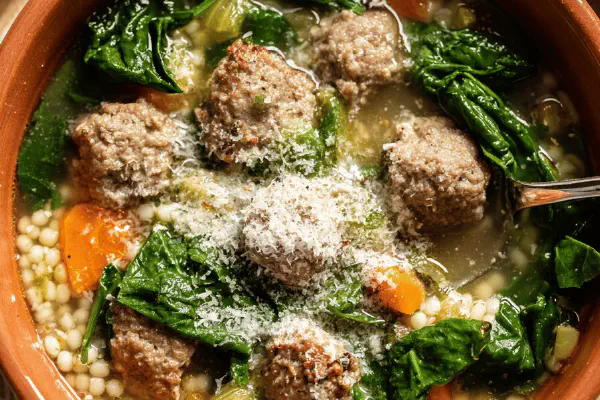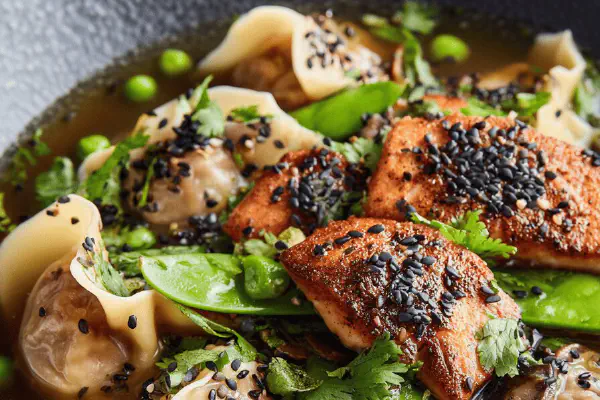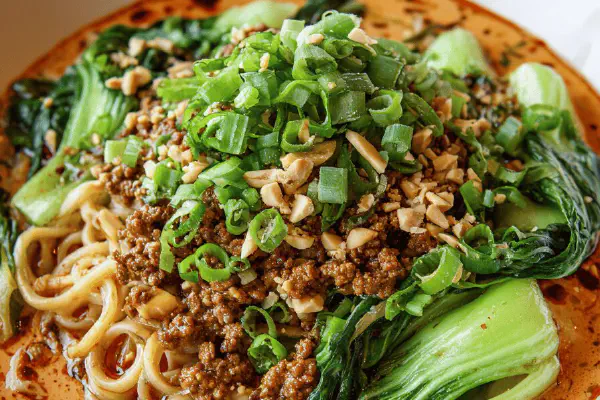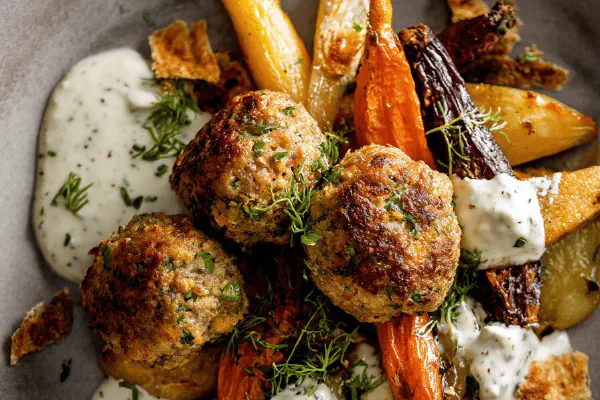Quinoa Pork Meatball Soup
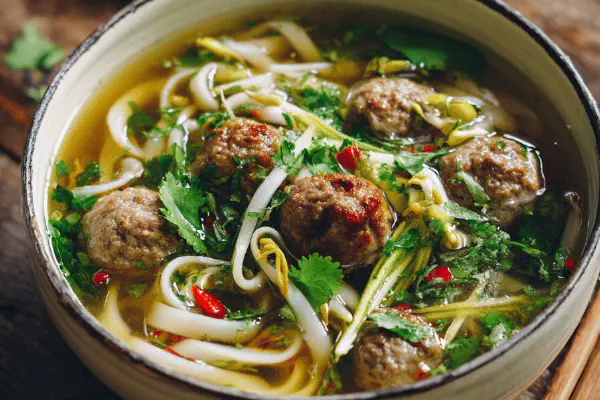
By Emma
Certified Culinary Professional
Ingredients
Meatballs
- 85 g quinoa (about 1/2 cup), rinsed, drained
- 220 g lean ground pork
- 20 g panko breadcrumbs (heaping 1/4 cup)
- 1 egg
- 2 scallions, finely chopped
- 1 clove garlic, minced
- 5 ml toasted sesame oil (1 tsp)
- 7 ml sambal oelek (1 1/2 tsp)
- 12 ml soy sauce (2 1/2 tsp)
- 12 ml mirin (2 1/2 tsp)
- 55 ml hoisin sauce (3 1/2 tbsp)
- 25 ml vegetable oil (2 tbsp)
Broth
- 4 scallions halved
- 2 pieces ginger 2.5 cm (1 inch) each
- 1 garlic clove
- 15 ml vegetable oil (1 tbsp)
- 2 liters chicken broth (8 cups)
- 30 g coriander stems (1 cup)
- 2 packs 200 g each pre-cooked udon noodles
- 225 g mung bean sprouts (about 3 cups)
- 30 g fresh coriander leaves (1 cup)
About the ingredients
Method
Meatballs Preparation
- Cook quinoa in boiling salted water until tender but still slightly firm, about 14-16 minutes; drain through fine sieve and rinse cold. Press quinoa gently to remove excess moisture—not mush, just dry enough to bind well.
- In bowl, stir pork, quinoa, panko, egg, scallions, garlic, toasted sesame oil, sambal oelek. Season liberally with salt and black pepper. Mix until homogenuous but don’t overwork—texture matters.
- Oil hands lightly; portion tablespoon-sized meatball shapes. Place on plate, chill 10 minutes to firm up. This helps keep shape when frying.
- Whisk together soy sauce, mirin, hoisin. Set aside.
Broth Preparation
- Heat vegetable oil in large pot over medium-high. Toss in scallion halves, ginger pieces, whole garlic clove. Stir until fragrant and just starting to brown, about 3-4 minutes. Watch for sizzle, shifting aroma — important aromatics releasing oils.
- Add chicken broth and coriander stems. Bring to boil and reduce to simmer. Let steep 9-11 minutes, flavors infuse but not overpower. Season lightly as needed with salt and pepper.
- Strain broth through fine sieve, discard solids. Return clear broth to pot, bring back to boil gently.
- Add udon noodles directly without stirring (to keep strands intact). Cover pot, reduce heat to low, and poach noodles 4-5 minutes. They should soften but not break apart.
- Keep broth warm, do not overcook noodles—they finish in bowls.
Cooking Meatballs
- Heat non-stick skillet over medium. Add half vegetable oil amount to coat pan. Brown half meatballs first, about 4 minutes per side. They firm, brown caramel crust forms—listen for steady sizzling, no burning—important for texture and flavor.
- Add remaining meatballs, brown all sides for another 3-4 minutes; add reserved sauce mix. Stir gently to coat meatballs evenly. Sauce will thicken, caramelizing on surface, sticky glaze clinging. Cook 1-2 minutes more until sauce thickens and shines.
- Remove from heat; meatballs rested briefly to set glaze.
Assembly
- Divide noodles and broth evenly into large bowls. Spoon warm meatballs on top. Scatter mung bean sprouts and torn coriander leaves for crunch and fresh herbal bite.
- Serve immediately before noodles absorb too much broth; fresh topping crunch key contrast.
Notes upon process
- Supporting swaps: quinoa can be replaced with cooked barley or couscous for texture variation. Pork can be swapped with ground chicken or turkey but watch moisture and fat content—may need to adjust binding agent. Sambal oelek can be toned down or swapped with another chili paste.
- If broth cloudy, strain twice or clarify with egg whites if needed. Avoid over stirring noodles to keep strand integrity.
- Meatball texture cues: should be firm but springy, not dry. Adjust panko or egg slightly if too wet or dry. Keeping hands oiled prevents sticking during shaping.
- Sauce caramel forms when bubbles tighten, sauce thickens and clings richly. Too high heat burns; regulate medium is best.
- Mung bean sprouts and coriander added last to maintain crisp texture and bright flavor contrast.
- Timing flexible but watching for sensory cues—aroma of broth, sizzle sound of meatballs, color and texture changes—yields the best results.
Cooking tips
Chef's notes
- 💡 Cook quinoa till just tender, not mush. Listen for gentle simmer bubbles not full boil. Rinse quinoa cold immediately to stop cooking and reduce stickiness. Press to remove excess moisture — keeps meatballs firm not soggy. Found that slight dampness binds best; too wet means balls break apart, too dry turns them tough.
- 💡 Mix meatball ingredients gently; overworking toughens. Salt early for seasoning and texture benefits. Chill shaped meatballs at least 10 minutes to firm. Skipping chill risks breakage when frying. Oil hands lightly to prevent sticking but avoid excess oil altering meatball surface texture.
- 💡 Browning meatballs on medium heat; listen for steady sizzle. When sound drops, caramelization begins. Avoid overcrowding pan; color uneven if packed. Adding sauce at browning’s end thickens quickly, stick glaze forms. Watch carefully, medium heat only, burns ruin flavor quickly.
- 💡 Simmer broth with aromatics just 9-11 minutes. Too long brings bitter notes especially from coriander stems. Stirring noodles ruins texture—add directly, cover, poach 4-5 minutes. Soft but intact strands best. Reserve broth warmth, finish noodles in bowl to avoid mush.
- 💡 Toppings last minute: fresh mung bean sprouts and torn coriander leaves add crunch, herbal brightness that cuts soft meat and noodles. Timing flexible but freshness key. Adjust sambal oelek heat according to brand or tolerance; mild chili paste works or fresh chili flakes as alternative.
Common questions
Can I swap quinoa with other grains?
Yes, barley or couscous work well, texture shifts slightly, barley chewier, couscous lighter. Remember moisture content differs, adjust binding agents accordingly; panko or egg maybe a bit more or less depending on grain moisture.
What if broth turns cloudy?
Strain it twice using fine mesh. Egg white clarification doable if you want super clear but delicate timing needed. Avoid stirring noodles vigorously; lost strands cloud broth, plus texture suffers. Cloudy means bits floating, clarity matters for visual and taste impact.
Meatballs fall apart during frying, fix?
Start by pressing quinoa well to remove moisture. Chill shaped meatballs adequately to firm. Adjust panko if mixture too wet. Avoid overmixing meat; gentle fold only. Oiled hands shape more cleanly. Searing on medium heat gives crust, which helps hold shape.
How to store leftovers?
Soup refrigerates 3-4 days fine, reheat gently, noodles can get soft if microwaved too long. Freeze broth and meatballs separately for better texture. Quick thaw, rewarm on stove with care to avoid drying meatballs. Fresh toppings always add at serving; they lose crunch stored.
